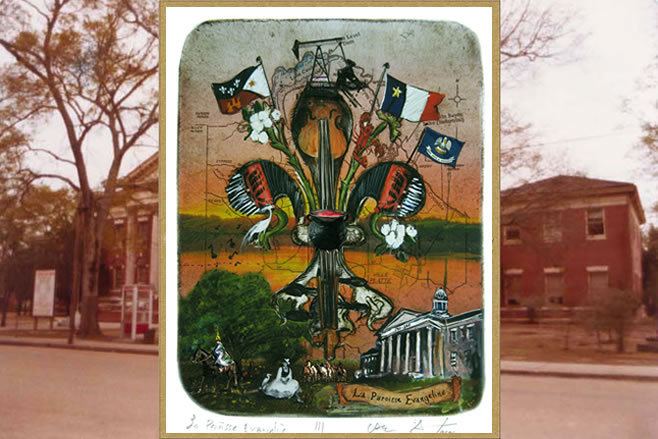Founded 1910 Unemployment rate 7.4% (Apr 2015) | Congressional district 5th Area 1,761 km² Population 33,578 (2013) | |
 | ||
Rivers Cocodrie, Bayou, Grand Louis, Bayou | ||
Evangeline Parish (French: Paroisse d'Évangéline) is a parish located in the U.S. state of Louisiana. As of the 2010 census, the population was 33,984. The parish seat is Ville Platte.
Contents
- Map of Evangeline Parish LA USA
- History
- Geography
- Major highways
- Adjacent parishes
- National protected area
- Demographics
- Education
- City
- Towns
- Villages
- Census designated place
- Other unincorporated places
- Notable residents
- National Guard
- References
Map of Evangeline Parish, LA, USA
History
The parish was created out of lands formerly belonging to St. Landry Parish in 1910. The majority of the area were originally settled by colonist French directly from France, and former colonial Canadian marines (coureurs de bois) previously from Fort Toulouse, Alabama to Fort Kaskaskia in the Illinois country and including later Napoleonic and 19th-century French and European French-speaking soldier and immigrant families.
The early generations born in colonial French colonies, which included the enormous Louisiana Territory ('Upper and Lower' Louisiana) was known as "la Nouvelle France" and included this region, then under Spanish rule, and whose citizens were originally called Isleños.
Many people of Evangeline are primarily of French, English & Spanish descent in Colonial Louisiana. Some of the major families included Fontenot, Brignac, Ardoin, Bordelon, Vidrine, LaFleur, Chataignier, Dupre, Berza, Manuel, Ratelle, Fuselier, Landreneau, Andrepont, LeBas and Gobert, along with many others.
People of Canary Islands Spanish heritage can be found to have settled in the Parish, bearing names like Ortego, Rozas, De Soto and Casaneuva. Many English colonists that came to collect Louisiana territory married into French families, and some prominently held the surnames of Young, Reed, Langley and Buller.
A few Acadians such as Francois Pitre and his wife had settled the area between Evangeline and St. Landry parishes, preferring the rich pre-American and pre-Civil War era Cajun planter's lifestyle over that of the humble and isolated existence of their Acadian Coast cousins.
The parish was named Evangeline in honor of Henry Wadsworth Longfellow's narrative poem, Evangeline. Evangeline Parish is mentioned in the Randy Newman song "Louisiana 1927", in which he described the Great Mississippi Flood which covered it with six feet of water. It was from this poem that founding father, Paulin Fontenot was to propose the namesake of "Evangeline" for this parish, allegedly foreseeing an emerging American tourism centered upon the Acadian saga.(See Ville Platte Gazette, Sept. 2010) In 19th-century American literature, she would gain popularity through Hollywood's interest, and thus began the embryonic 'Acadian-based' tourism which sprang up in St. Martinville.
Ville Platte, Louisiana, the capitol seat of Evangeline Parish, was itself so named by one of Napoleon Bonaparte's former soldiers, Adjutant Major, Marcellin Garand (1781-1852), of Savoy, France. (See Napoleon's Soldiers In America, by Simone de la Souchere-Delery, 1999).
Geography
According to the U.S. Census Bureau, the parish has a total area of 680 square miles (1,800 km2), of which 662 square miles (1,710 km2) is land and 17 square miles (44 km2) (2.5%) is water.
Major highways
Adjacent parishes
National protected area
Demographics
As of the 2010 United States Census, there were 33,984 people residing in the parish. 69.0% were White, 28.3% Black or African American, 0.3% Asian, 0.3% Native American, 1.0% of some other race and 1.1% of two or more races. 2.3% were Hispanic or Latino (of any race). 40.0% were of French, French Canadian or Cajun and 9.1% American ancestry.
As of the census of 2000, there were 35,434 people, 12,736 households, and 9,157 families residing in the parish. The population density was 53 people per square mile (21/km²). There were 14,258 housing units at an average density of 22 per square mile (8/km²). The racial makeup of the parish was 70.42% White, 28.57% Black or African American, 0.23% Native American, 0.14% Asian, 0.01% Pacific Islander, 0.18% from other races, and 0.46% from two or more races. 1.04% of the population were Hispanic or Latino of any race. 25.71% reported speaking French or Cajun French at home, the highest percentage of any Louisiana parish.
There were 12,736 households out of which 38.00% had children under the age of 18 living with them, 52.30% were married couples living together, 15.50% had a female householder with no husband present, and 28.10% were non-families. 25.80% of all households were made up of individuals and 11.90% had someone living alone who was 65 years of age or older. The average household size was 2.64 and the average family size was 3.19.
In the parish the population was spread out with 29.60% under the age of 18, 9.60% from 18 to 24, 27.60% from 25 to 44, 20.40% from 45 to 64, and 12.80% who were 65 years of age or older. The median age was 34 years. For every 100 females there were 99.40 males. For every 100 females age 18 and over, there were 98.10 males.
The median income for a household in the parish was $20,532, and the median income for a family was $27,243. Males had a median income of $30,386 versus $16,793 for females. The per capita income for the parish was $11,432. About 27.20% of families and 32.20% of the population were below the poverty line, including 39.10% of those under age 18 and 31.00% of those age 65 or over.
Education
Public Schools in Evangeline Parish are operated by the Evangeline Parish School Board.
Roman Catholic schools include Sacred Heart Elementary (K-8) and Sacred Heart of Jesus Catholic High School (9-12), both located in the parish seat of Ville Platte, Louisiana.
City
Towns
Villages
Census-designated place
Other unincorporated places
Notable residents
National Guard
The 1086TH Transportation Company of the 165TH CSS (Combat Service Support) Battalion resides in Ville Platte, Louisiana. This unit belongs to the 139TH RSG (regional support group).
